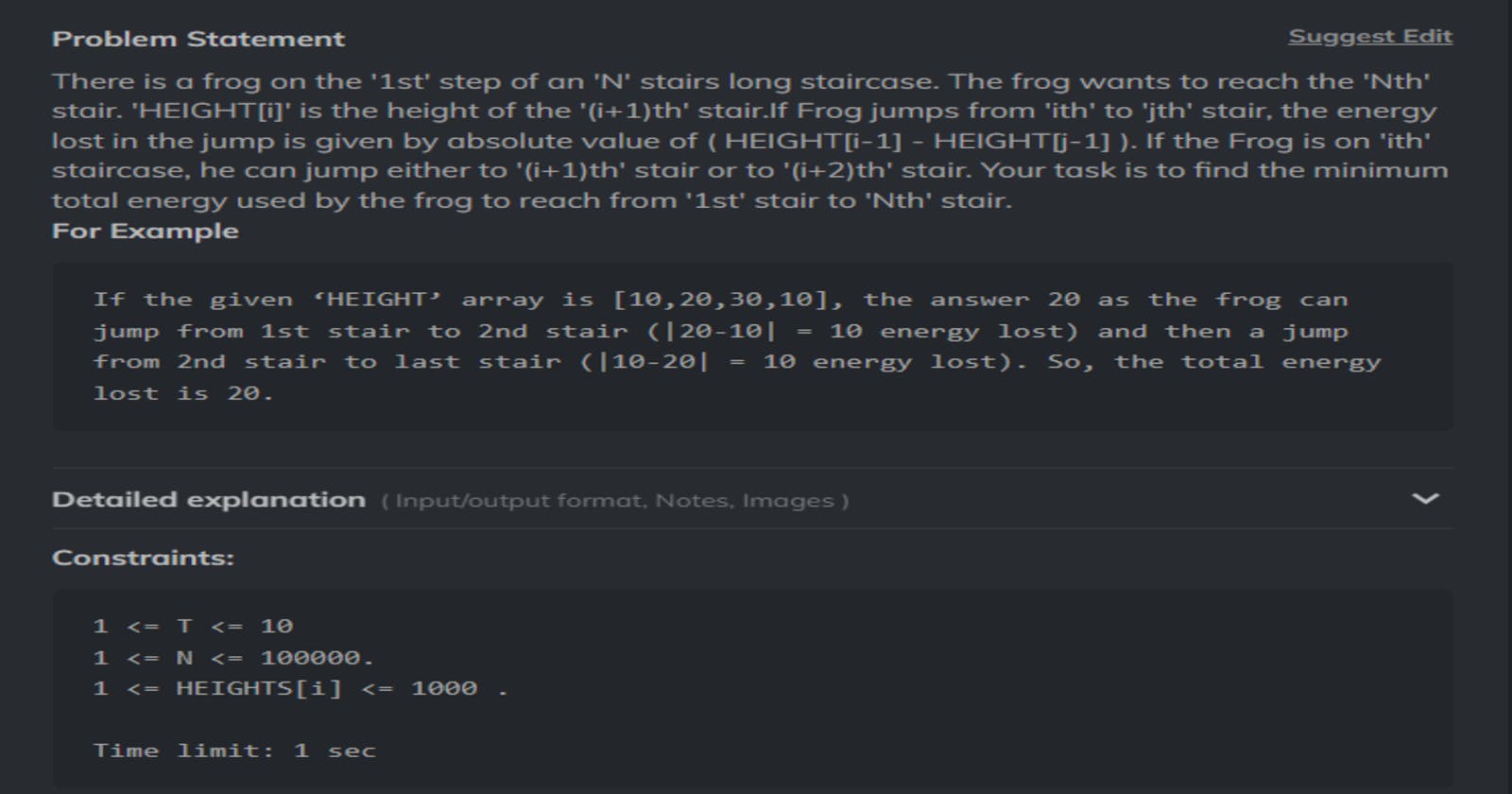Daily Dose of DSA - Day 19
Frog jump using Rec DP(Top-Down Approach)(TC : O(n) & SC : O(n + n (call stack))& Itr DP( Bottom-up Approach)(TC : O(n) & SC : O(n)(O(1) in Sp.Optim))
Table of contents
Question Link : https://www.codingninjas.com/studio/problems/frog-jump_3621012?leftPanelTab=0
PermalinkUsing Recursive DP :
The function
recis a recursive function that calculates the minimum cost of reaching theindexposition in theheightsvector.The
dpvector is used to store the minimum cost at each position. The initial values of thedpvector are set to -1, indicating that they haven't been calculated yet.If the minimum cost for the
indexposition has already been calculated (i.e.,dp[index] != -1), it is directly returned.Otherwise, two possibilities are considered: a. Jumping from the previous position to the current position (
x = rec(index-1, dp, heights) + abs(heights[index] - heights[index-1])). b. Jumping from two positions back to the current position (y = rec(index-2, dp, heights) + abs(heights[index] - heights[index-2])).The minimum cost between
xandyis calculated using theminfunction and stored indp[index]. This value is also returned.The
frogJumpfunction initializes thedpvector with sizenand calls therecfunction withn-1as the starting index. It returns the minimum cost to reach the last position (dp[n-1]). the code finds the minimum cost of jumping from one position to another in theheightsvector, considering that the frog can jump one or two positions at a time. The dynamic programming approach is used to avoid redundant calculations by storing and reusing the minimum costs.
#include <bits/stdc++.h>
int rec(int index,vector<int>&dp,vector<int>&heights)
{
if(index==0) return 0;
if(dp[index]!=-1) return dp[index];
int x = rec(index-1,dp,heights)+abs(heights[index]-heights[index-1]);
int y = INT_MAX;
if(index>1)
y = rec(index-2,dp,heights)+abs(heights[index]-heights[index-2]);
return dp[index]=min(x,y);
}
int frogJump(int n, vector<int> &heights)
{
vector<int>dp(n,-1);
return rec(n-1,dp,heights);
}
PermalinkUsing Iterative DP:
The
recfunction iterates through the positions of theheightsvector starting from indexiand calculates the minimum cost to reach each position.Inside the loop, two variables
xandyare initialized.xrepresents the cost of jumping from the previous position to the current position, andyrepresents the cost of jumping from two positions back to the current position.The minimum cost between
xandyis calculated using theminfunction and stored in thedpvector at the current position.By continuously updating the
dpvector in each iteration, the loop calculates the minimum cost for each position, moving from left to right.The
frogJumpfunction initializes thedpvector with sizenand sets the first position's cost to 0 (since the frog is already at the first position).It then calls the
recfunction starting from the second position (rec(1, dp, heights)), which fills in thedpvector with the minimum costs for each position.Finally, the function returns the minimum cost to reach the last position, which is stored in
dp[n-1].
In simple terms, the code uses a loop to calculate the minimum cost for each position in the heights vector. It considers two possibilities: jumping from the previous position or jumping from two positions back. By continuously updating the dp vector, it finds the minimum cost for each position, starting from the second position. The final result is the minimum cost to reach the last position.
#include <bits/stdc++.h>
void rec(int i,vector<int>&dp,vector<int>&heights)
{
int n = (int)heights.size();
for(i;i<n;i++)
{
int x,y=INT_MAX;
x = dp[i-1] + abs(heights[i]-heights[i-1]);
if(i>1)
{
y = dp[i-2] + abs(heights[i]-heights[i-2]);
}
dp[i] = min(x,y);
}
}
int frogJump(int n, vector<int> &heights)
{
vector<int>dp(n,0);
dp[0]=0;
rec(1,dp,heights);
return dp[n-1];
}
PermalinkSpace Optimization :
The
recfunction iterates through the positions of theheightsvector starting from indexiand calculates the minimum cost to reach each position.Inside the loop, three variables are used:
prev,prev2, andcurr.prevrepresents the minimum cost of the previous position,prev2represents the minimum cost of two positions back, andcurrrepresents the current minimum cost.The minimum cost
xof jumping from the previous position to the current position is calculated by addingprevwith the absolute difference between the current and previous heights.If the current position is greater than index 1, the minimum cost
yof jumping from two positions back to the current position is calculated by addingprev2with the absolute difference between the current and two positions back heights.The minimum cost between
xandyis stored incurr.In each iteration, the values of
prev2andprevare updated.prev2is assigned the value ofprev, andprevis assigned the value ofcurr.After the loop finishes, the final minimum cost to reach the last position is stored in
prev.The
frogJumpfunction calls therecfunction starting from the second position (rec(1, heights)), and it returns the final minimum cost.
In simple terms, the code uses a loop to calculate the minimum cost for each position in the heights vector. It keeps track of the minimum costs of the previous position and two positions back. By iteratively updating these values, it finds the minimum cost to reach the last position. The final result is returned as the minimum cost for the frog to jump from the second position to the last position.
#include <bits/stdc++.h>
int rec(int i,vector<int>&heights)
{
int n = (int)heights.size();
int prev = 0;
int prev2 = 0;
for( i;i<n;i++)
{
int x,y=INT_MAX;
x = prev + abs(heights[i]-heights[i-1]);
if(i>1)
{
y = prev2 + abs(heights[i]-heights[i-2]);
}
int curr = min(x,y);
prev2 = prev;
prev = curr;
}
return prev;
}
int frogJump(int n, vector<int> &heights)
{
return rec(1,heights);
}
Subscribe to our newsletter
Read articles from directly inside your inbox. Subscribe to the newsletter, and don't miss out.
